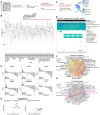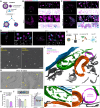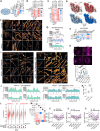This is a preprint.
Global cellular proteo-lipidomic profiling of diverse lysosomal storage disease mutants using nMOST
- PMID: 38585873
- PMCID: PMC10996675
- DOI: 10.1101/2024.03.26.586828
Global cellular proteo-lipidomic profiling of diverse lysosomal storage disease mutants using nMOST
Update in
-
Global cellular proteo-lipidomic profiling of diverse lysosomal storage disease mutants using nMOST.Sci Adv. 2025 Jan 24;11(4):eadu5787. doi: 10.1126/sciadv.adu5787. Epub 2025 Jan 22. Sci Adv. 2025. PMID: 39841834 Free PMC article.
Abstract
Lysosomal storage diseases (LSDs) comprise ~50 monogenic disorders marked by the buildup of cellular material in lysosomes, yet systematic global molecular phenotyping of proteins and lipids is lacking. We present a nanoflow-based multi-omic single-shot technology (nMOST) workflow that quantifies HeLa cell proteomes and lipidomes from over two dozen LSD mutants. Global cross-correlation analysis between lipids and proteins identified autophagy defects, notably the accumulation of ferritinophagy substrates and receptors, especially in NPC1 -/- and NPC2 -/- mutants, where lysosomes accumulate cholesterol. Autophagic and endocytic cargo delivery failures correlated with elevated lyso-phosphatidylcholine species and multi-lamellar structures visualized by cryo-electron tomography. Loss of mitochondrial cristae, MICOS-complex components, and OXPHOS components rich in iron-sulfur cluster proteins in NPC2 -/- cells was largely alleviated when iron was provided through the transferrin system. This study reveals how lysosomal dysfunction affects mitochondrial homeostasis and underscores nMOST as a valuable discovery tool for identifying molecular phenotypes across LSDs.
Keywords: Lysosome storage disorders; autophagy; cryo-ET; ferritinophagy; iNeuron; lipidomics; mitochondrial dysfunction; multi-omics; proteomics.
Conflict of interest statement
DECLARATION OF INTERESTS J.W.H. is a consultant and founder of Caraway Therapeutics (a wholly owned subsidiary of Merck & Co, Inc) and is a member of the scientific advisory board for Lyterian Therapeutics. B.A.S. is a co-founding scientific advisory board member of Interline Therapeutics and on the scientific advisory boards of Biotheryx and Proxygen. J.M.P. holds a position on the advisory board of Thermo Fisher Scientific. J.J.C. is a consultant for Thermo Fischer Scientific. Other authors declare no competing interests. S.P.G. is on the advisory board for Thermo Fisher Scientific, Cedilla Therapeutics, Casma Therapeutics, Cell Signaling Technology, and Frontier Medicines.
Figures







References
-
- Robak L.A., Jansen I.E., van Rooij J., Uitterlinden A.G., Kraaij R., Jankovic J., International Parkinson’s Disease Genomics, C., Heutink P., and Shulman J.M. (2017). Excessive burden of lysosomal storage disorder gene variants in Parkinson’s disease. Brain 140, 3191–3203. 10.1093/brain/awx285. - DOI - PMC - PubMed
-
- Alcalay R.N., Mallett V., Vanderperre B., Tavassoly O., Dauvilliers Y., Wu R.Y.J., Ruskey J.A., Leblond C.S., Ambalavanan A., Laurent S.B., et al. (2019). SMPD1 mutations, activity, and alpha-synuclein accumulation in Parkinson’s disease. Mov Disord 34, 526–535. 10.1002/mds.27642. - DOI - PMC - PubMed
Publication types
Grants and funding
LinkOut - more resources
Full Text Sources
Research Materials
